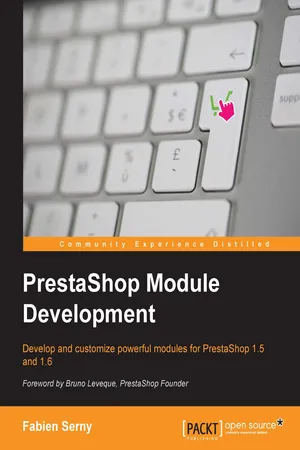![]()
PrestaShop Module Development
![]()
Table of Contents
PrestaShop Module Development
Credits
Foreword
About the Author
About the Reviewers
www.PacktPub.com
Support files, eBooks, discount offers, and more
Why subscribe?
Free access for Packt account holders
Preface
What this book covers
What you need for this book
Who this book is for
Conventions
Reader feedback
Customer support
Downloading the example code
Downloading the color images of this book
Errata
Piracy
Questions
1. Creating a New Module
First steps
Adding the module configuration
Making a simple configuration form
Summary
2. Hooks
Registering our module on hooks
Changing the position of your module on a hook
Using hooks to display templates
Using the database class to save comments
Displaying comments
Triggering hooks
Adding a hook
The dynamic hooks
Summary
3. Using Context and its Methods
Looking at the Context object
Using the translate method
Adding CSS and JS in your module
Checking compatibilities and dependencies
The compatibility check
The dependency check
Summary
4. Building Module Updates
Creating a database table on module installation
Deleting a table on uninstallation
Upgrading your module
Updating the module code
Adding a callback to options
Summary
5. Front Controllers, Object Models, and Overrides
Using front controllers to create a new page
Creating the front controller
Maintaining compatibility with the Friendly URL option
Creating a small action dispatcher
Displaying the product name and comments
Including CSS and JS media in the controller
Adding a pagination system
Creating routes for a module's controller
Installing overrides with modules
Creating the override class
Editing the template file to display grades on products list
Creating a new method in a native class
Using object models to create cleaner code
Creating the ObjectModel class
Using the ObjectModel class in our module
Placing all the database requests in our ObjectModel class
Using HelperForm to make a scalable form
Cleaning your code using the hook's controller
Summary
6. Admin Controllers and Hooks
Adding an admin controller
Adding and installing a new tab to your admin panel
Uninstalling the tab when the module is uninstalled
Listing comments in your admin controller
Improving the list view
Adding actions on the list view
Creating your own view template
Configuring your form view
Using back office hooks
Attaching your module to a product hook
Displaying comments in a product hook
Displaying comments associated with a customer
Making links between admin sections
Summary
7. The Carrier Module
First step to create a carrier module
Using web services
API description
Module configuration
Creating new carriers
Using web services on shipping cost calculation
Handling carrier update
Displaying relay points
Associating the chosen relay point with the cart
Displaying the customer's choice in the back office
Summary
8. The Payment Module
Creating a payment module
Creating the payment controller
Checking the currency
Validating a cart into an order
Displaying information on the order confirmation page
Creating your own order state
Associating an e-mail with an order state
Working with a third-party API
Updating the module's configuration form
Displaying the new payment method
Building the validation API controller
Summary
9. Multistore
Configuring the multistore feature on your PrestaShop
Enabling the multistore feature
Creating a new shop
Updating the MySQL table of the module
Updating the module code
Updating the ObjectModel class
Using Context in the get method
Updating the AdminController class
Using the Configuration class with multistore
Summary
10. Security and Performance
Securing your module
Protecting your module against directory listing
Forbidding direct access to class and controller files
Protecting your code against SQL injection
Protecting your templates against XSS
Verifying the data with MD5 hash
Searching for malicious code in modules
Checking for unusual e-mail sending
Checking for strange URL calls
Checking the use of eval
Checking the use of system, exec, and backquotes
Checking the use of base64_decode
Wrapping up on this section
Performance and optimization
Using Combine, Compress, and Cache
Using the cache system
Using the Smarty cache
Summary
A. Native Hooks
The list of all the dynamic hooks
Definitions of the variables
Index
![]()
PrestaShop Module Development
Copyright © 2014 Packt Publishing
All rights reserved. No part of this book may be reproduced, stored in a retrieval system, or transmitted in any form or by any means, without the prior written permission of the publisher, except in the case of brief quotations embedded in critical articles or reviews.
Every effort has been made in the preparation of this book to ensure the accuracy of the information presented. However, the information contained in this book is sold without warranty, either express or implied. Neither the author, nor Packt ...
